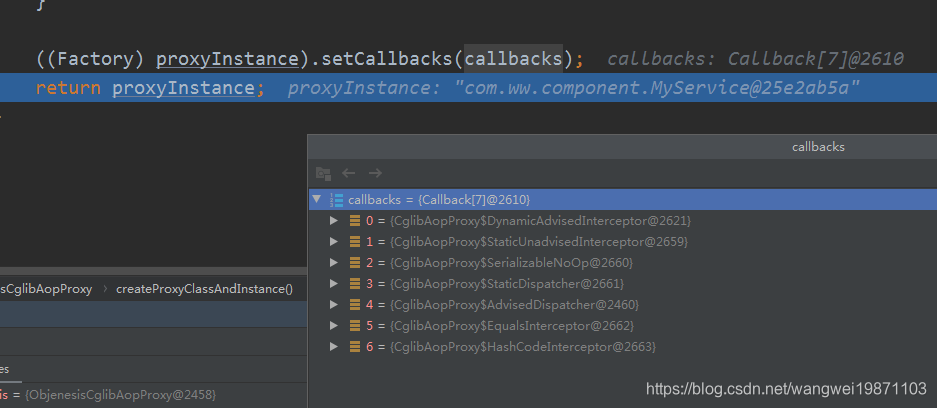JdkDynamicAopProxy的getProxy
主要是JdkDynamicAopProxy在代理前还有一些事情要说下:

AopProxyUtils的completeProxiedInterfaces
这里说白了就是增加一些其他的接口SpringProxy,DecoratingProxy,Advised。
static Class<?>[] completeProxiedInterfaces(AdvisedSupport advised, boolean decoratingProxy) {
Class<?>[] specifiedInterfaces = advised.getProxiedInterfaces();
if (specifiedInterfaces.length == 0) {
// No user-specified interfaces: check whether target class is an interface.
Class<?> targetClass = advised.getTargetClass();
if (targetClass != null) {
if (targetClass.isInterface()) {
advised.setInterfaces(targetClass);
}
else if (Proxy.isProxyClass(targetClass)) {
advised.setInterfaces(targetClass.getInterfaces());
}
specifiedInterfaces = advised.getProxiedInterfaces();
}
}
boolean addSpringProxy = !advised.isInterfaceProxied(SpringProxy.class);
boolean addAdvised = !advised.isOpaque() && !advised.isInterfaceProxied(Advised.class);
boolean addDecoratingProxy = (decoratingProxy && !advised.isInterfaceProxied(DecoratingProxy.class));
int nonUserIfcCount = 0;
if (addSpringProxy) {//需要添加SpringProxy接口
nonUserIfcCount++;
}
if (addAdvised) {//需要添加通知
nonUserIfcCount++;
}
if (addDecoratingProxy) {//需要添加DecoratingProxy接口
nonUserIfcCount++;
}
Class<?>[] proxiedInterfaces = new Class<?>[specifiedInterfaces.length + nonUserIfcCount];
System.arraycopy(specifiedInterfaces, 0, proxiedInterfaces, 0, specifiedInterfaces.length);
int index = specifiedInterfaces.length;
if (addSpringProxy) {
proxiedInterfaces[index] = SpringProxy.class;
index++;
}
if (addAdvised) {
proxiedInterfaces[index] = Advised.class;
index++;
}
if (addDecoratingProxy) {
proxiedInterfaces[index] = DecoratingProxy.class;
}
return proxiedInterfaces;
}

CglibAopProxy的getProxy
就是CGLIB的基本用法,创建增强器,拦截器,设置父类等
@Override
public Object getProxy(@Nullable ClassLoader classLoader) {
if (logger.isTraceEnabled()) {
logger.trace("Creating CGLIB proxy: " + this.advised.getTargetSource());
}
try {
Class<?> rootClass = this.advised.getTargetClass();
Assert.state(rootClass != null, "Target class must be available for creating a CGLIB proxy");
Class<?> proxySuperClass = rootClass;
if (rootClass.getName().contains(ClassUtils.CGLIB_CLASS_SEPARATOR)) {//类名是否包含CGLIB分隔符
proxySuperClass = rootClass.getSuperclass();
Class<?>[] additionalInterfaces = rootClass.getInterfaces();//获得原始父类的接口
for (Class<?> additionalInterface : additionalInterfaces) {
this.advised.addInterface(additionalInterface);
}
}
//验证修饰符和方法修饰符
// Validate the class, writing log messages as necessary.
validateClassIfNecessary(proxySuperClass, classLoader);
// Configure CGLIB Enhancer...
Enhancer enhancer = createEnhancer();//增强器
if (classLoader != null) {
enhancer.setClassLoader(classLoader);
if (classLoader instanceof SmartClassLoader &&
((SmartClassLoader) classLoader).isClassReloadable(proxySuperClass)) {
enhancer.setUseCache(false);
}
}
enhancer.setSuperclass(proxySuperClass);//父类
enhancer.setInterfaces(AopProxyUtils.completeProxiedInterfaces(this.advised));
enhancer.setNamingPolicy(SpringNamingPolicy.INSTANCE);
enhancer.setStrategy(new ClassLoaderAwareGeneratorStrategy(classLoader));
Callback[] callbacks = getCallbacks(rootClass);
Class<?>[] types = new Class<?>[callbacks.length];
for (int x = 0; x < types.length; x++) {
types[x] = callbacks[x].getClass();
}
// fixedInterceptorMap only populated at this point, after getCallbacks call above
enhancer.setCallbackFilter(new ProxyCallbackFilter(
this.advised.getConfigurationOnlyCopy(), this.fixedInterceptorMap, this.fixedInterceptorOffset));
enhancer.setCallbackTypes(types);
// Generate the proxy class and create a proxy instance.
return createProxyClassAndInstance(enhancer, callbacks);
}
catch (CodeGenerationException | IllegalArgumentException ex) {
throw new AopConfigException("Could not generate CGLIB subclass of " + this.advised.getTargetClass() +
": Common causes of this problem include using a final class or a non-visible class",
ex);
}
catch (Throwable ex) {
// TargetSource.getTarget() failed
throw new AopConfigException("Unexpected AOP exception", ex);
}
}
ObjenesisCglibAopProxy的createProxyClassAndInstance
生成代理类,然后用objenesis生成实例。
@Override
protected Object createProxyClassAndInstance(Enhancer enhancer, Callback[] callbacks) {
Class<?> proxyClass = enhancer.createClass();
Object proxyInstance = null;
if (objenesis.isWorthTrying()) {
try {
proxyInstance = objenesis.newInstance(proxyClass, enhancer.getUseCache());
}
catch (Throwable ex) {
logger.debug("Unable to instantiate proxy using Objenesis, " +
"falling back to regular proxy construction", ex);
}
}
if (proxyInstance == null) {
// Regular instantiation via default constructor...
try {
Constructor<?> ctor = (this.constructorArgs != null ?
proxyClass.getDeclaredConstructor(this.constructorArgTypes) :
proxyClass.getDeclaredConstructor());
ReflectionUtils.makeAccessible(ctor);
proxyInstance = (this.constructorArgs != null ?
ctor.newInstance(this.constructorArgs) : ctor.newInstance());
}
catch (Throwable ex) {
throw new AopConfigException("Unable to instantiate proxy using Objenesis, " +
"and regular proxy instantiation via default constructor fails as well", ex);
}
}
((Factory) proxyInstance).setCallbacks(callbacks);
return proxyInstance;
}
最后还会设置一些回调器:

了解到这里就差不多知道是怎么生成AOP代理了,接下去就看看哪些方法是怎么执行的吧。
好了,今天就到这里了,希望对学习理解有帮助,大神看见勿喷,仅为自己的学习理解,能力有限,请多包涵。
Java 面试宝典是大明哥全力打造的 Java 精品面试题,它是一份靠谱、强大、详细、经典的 Java 后端面试宝典。它不仅仅只是一道道面试题,而是一套完整的 Java 知识体系,一套你 Java 知识点的扫盲贴。
它的内容包括:
- 大厂真题:Java 面试宝典里面的题目都是最近几年的高频的大厂面试真题。
- 原创内容:Java 面试宝典内容全部都是大明哥原创,内容全面且通俗易懂,回答部分可以直接作为面试回答内容。
- 持续更新:一次购买,永久有效。大明哥会持续更新 3+ 年,累计更新 1000+,宝典会不断迭代更新,保证最新、最全面。
- 覆盖全面:本宝典累计更新 1000+,从 Java 入门到 Java 架构的高频面试题,实现 360° 全覆盖。
- 不止面试:内容包含面试题解析、内容详解、知识扩展,它不仅仅只是一份面试题,更是一套完整的 Java 知识体系。
- 宝典详情:https://www.yuque.com/chenssy/sike-java/xvlo920axlp7sf4k
- 宝典总览:https://www.yuque.com/chenssy/sike-java/yogsehzntzgp4ly1
- 宝典进展:https://www.yuque.com/chenssy/sike-java/en9ned7loo47z5aw
目前 Java 面试宝典累计更新 400+ 道,总字数 42w+。大明哥还在持续更新中,下图是大明哥在 2024-12 月份的更新情况:

想了解详情的小伙伴,扫描下面二维码加大明哥微信【daming091】咨询

同时,大明哥也整理一套目前市面最常见的热点面试题。微信搜[大明哥聊 Java]或扫描下方二维码关注大明哥的原创公众号[大明哥聊 Java] ,回复【面试题】 即可免费领取。

